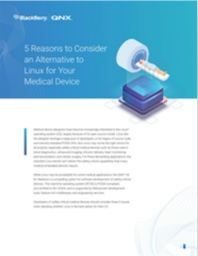5 Reasons to Consider an Alternative to Linux for Your Medical Device
Medical device designers have become increasingly interested in the Linux® operating system (OS), largely because of its open source model. Linux lets the designer leverage a large pool of developers, a rich legacy of source code, and industry-standard POSIX APIs.
But Linux may not be the right choice for all projects, especially safety-critical medical devices such as those used in blood diagnostics, ultrasound imaging, infusion delivery, heart monitoring and resuscitation, and robotic surgery. For these demanding applications, the standard Linux kernel can't deliver the safety-critical capabilities that many medical embedded devices require.
Not every medical device application requires a safety-certified operating system. For many of those applications, Linux can be an appropriate option. But for life- or safety-critical embedded systems that must operate 24 hours a day, 365 days a year, without failure, the QNX OS for Medical is a proven, reliable choice.
Read More
By submitting this form you agree to BlackBerry QNX contacting you with marketing-related emails or by telephone. You may unsubscribe at any time. BlackBerry QNX web sites and communications are subject to their Privacy Notice.
By requesting this resource you agree to our terms of use. All data is protected by our Privacy Notice. If you have any further questions please email dataprotection@techpublishhub.com
Related Categories: Cellular, Communication, Development and debug tools, Edge computing, Embedded, Embedded operating systems and software, Evaluation boards, LPWAN technologies, Microcontrollers, Near-Field Communication (NFC), SBCs and modules, Sub-GHz/ISM-band radio, Wireless networking ICs and modules


More resources from BlackBerry QNX

Ultimate Guide to Real-time Operating Systems (RTOS)
A real-time operating system (RTOS) must be fast and responsive, schedule tasks and manage limited resources, and ensure functions are isolated and...

The Past, Present and Future of Cybersecurity for Embedded Systems
The only system that's safe from cyberthreats is one that's never powered on. While this is an overstatement meant to highlight the seriousness of ...

Accelerate Innovation: How Adopting a Scalable Platform Architecture can Speed Product Development
The pace of innovation has changed. Original equipment manufacturers (OEMs) can no longer take years to introduce new products or update functional...
